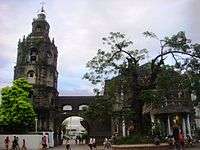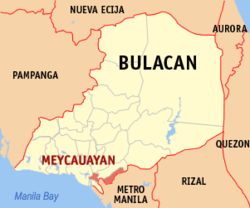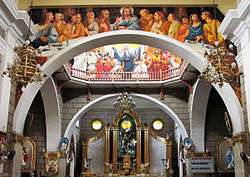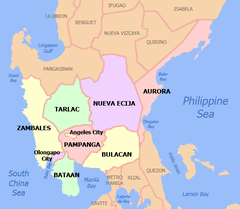Meycauayan
| Meycauayan | |
|---|---|
| Component City | |
| City of Meycauayan | |
  (From top, left to right: Meycauayan City Hall • St. Francis de Assisi Parish Church • Meycauayan River • NLEX tollgate • Malhacan • People's Market) | |
| Nickname(s): Hub of Jewelry in Bulacan | |
| Motto(s): Meycaueños, Taas Noo Sa Pagbabago! | |
 Map of Bulacan with Meycauayan highlighted | |
.svg.png) Meycauayan Location within the Philippines | |
| Coordinates: 14°44′N 120°57′E / 14.73°N 120.95°ECoordinates: 14°44′N 120°57′E / 14.73°N 120.95°E | |
| Country |
|
| Region | Central Luzon (Region III) |
| Province | Bulacan |
| District | 4th District |
| Founded | October 4, 1578 |
| Cityhood | December 10, 2006 |
| Barangays | 26 (see Barangays) |
| Government [1] | |
| • Type | Sangguniang Panlungsod |
| • Mayor | Henry R. Villarica |
| • Vice Mayor | Rafael S. Manzano, Jr. |
| • Congressman | Linabelle R. Villarica |
| • Electorate | 114,039 voters (2016) |
| Area [2] | |
| • Total | 32.10 km2 (12.39 sq mi) |
| Highest elevation | 45 m (148 ft) |
| Population (2015 census)[3] | |
| • Total | 209,083 |
| • Density | 6,500/km2 (17,000/sq mi) |
| Time zone | UTC+8 (PST) |
| ZIP code | 3020 |
| PSGC | 031412000 |
| IDD : area code | +63 (0)44 |
| Climate type | Tropical monsoon climate |
| Income class | 3rd city income class |
| Poverty rate |
|
| • Revenue (2017) |
|
| • Expenses (2017) |
|
| • Total Assets (2017) |
|
| Electricity | Manila Electric Company |
| • Consumption | 281.78 million kWh (2003) |
| Native languages |
Tagalog Taglish Swardspeak |
| Website |
www |
Meycauayan, officially the City of Meycauayan, (Tagalog: Lungsod ng Meycauayan), or simply known as Meycauayan City, is a 3rd class city in the province of Bulacan, Philippines. According to the 2015 census, it has a population of 209,083 people.[3]
The city is located 19 kilometres (12 mi) north of Manila and 26 kilometres (16 mi) south of Malolos City, the provincial capital city. It is bounded by the town of Marilao to the north, the cities of Valenzuela to the south and Caloocan (North) to the east, and the town of Obando to the west. It encompasses an aggregate area of 22.1 square kilometres (8.5 sq mi), representing 1.17% of the total land area of the province of Bulacan.
History
During the Spanish Colonization of the country, the town of Meycauayan was established as a settlement by a group of Spanish priests belonging to the Franciscan Order. In 1578, its early inhabitants came into contact with Christianity. In that same year, Father Juan de Placencia and Diego Oropesa built the first church structure, which was believed to be made of nipa and bamboo. Common to all Spanish settlements in that period was the adoption of a patron saint for the newly opened town. Meycauayan has St. Francis of Assisi as the Patron Saint. It was only in 1668, however, that a concrete church structure was erected.
Meycauayan was then one of the largest towns in the province of Bulacan. The towns, which fell under its political jurisdiction, were San Jose del Monte, Bocaue, Valenzuela (formerly Polo), Obando, Marilao, Sta. Maria and Pandi. It was also regarded as the unofficial capital of the province, being the hub of activities brought about by the establishment of the market center and the presence of the Spanish military detachment. During the revolution, which was set off by the execution of Dr. Jose Rizal in 1896, Meycauayan contributed its share in the fight against the Spanish conquistadores. Among her sons who figured prominently in the revolution were: Andres Pacheco, Ciriaco Contreras, Guillermo Contreras, Guillermo Bonque, and Liberato Exaltacion. There were many others who had joined the revolution and had displayed their exceptional heroism until 1898, when the country gained its independence.
In 1949, a big fire razed the market center and several business establishments in the town, causing setbacks to the development of the municipality. It took several years to recover from the destruction and property losses. However, in the 1960s and early part of 1970s, new hope for the development was ushered in. Reconstruction and rehabilitation of infrastructure facilities were made possible through the assistance of the provincial and national governments. A more sound economic base was established and crop production more than doubled.
On December 10, 2006, by virtue of Republic Act 9356, voters in Meycauayan ratified the conversion of Meycauayan into a component city of Bulacan through another plebiscite. It became the province's third city, joining San Jose del Monte and Malolos.
Today, the city of Meycauayan has transformed into a major economic and industrial hub in the Province of Bulacan and the rest of Region III.[5]
Geography
The City of Meycauayan is generally surrounded with plain land and gentle rolling hills. Meycauayan is named to Filipino phrase may kawayan that means "with bamboo". Comfortably above sea level, this terrain is an interweaving of greenery and concrete road network. The slope of the land dips towards a west to north westerly direction. River, natural lake and drainage waterways envelope and criss-cross the area.
Bulacan, a province of its name in its antiquity, is found between 120° 58’ 20” and the 127° 30’ longitude, with a latitude of 14° 41’ up to the 15°, the majority of the land, can be seen some mountains especially to the south east extension which do not exceed to same eleven leagues to the east or west and some six to the north and south. It is bordered to the east by the province of Nueva Ecija, and the district of Morong; to the South by Manila and her bay; to the West by Manila bay and the province of Pampanga, and to the North by the Province of Pampanga.[6] Today it is bordered by the town of Marilao to the north, towns of Bocaue and Bulakan, Bulacan to the northwest, Valenzuela to the south, Northern part of Caloocan to the east, and the town of Obando to the west.
Barangays
The City of Meycauayan is administratively subdivided into 26 urban barangays.
| PSGC | Barangay | Population | ±% p.a. | |||
|---|---|---|---|---|---|---|
| 2015[3] | 2010[7] | |||||
| 031412001 | Bagbaguin | 3.7% | 7,760 | 6,908 | 2.24% | |
| 031412002 | Bahay Pare | 5.5% | 11,568 | 10,221 | 2.39% | |
| 031412003 | Bancal | 6.0% | 12,589 | 14,242 | −2.32% | |
| 031412004 | Banga | 1.4% | 2,913 | 2,911 | 0.01% | |
| 031412005 | Bayugo | 8.9% | 18,560 | 17,982 | 0.60% | |
| 031412006 | Calvario | 2.5% | 5,317 | 5,009 | 1.14% | |
| 031412007 | Camalig | 4.3% | 8,972 | 8,042 | 2.11% | |
| 031412008 | Hulo | 0.8% | 1,675 | 1,636 | 0.45% | |
| 031412009 | Iba | 3.8% | 8,032 | 7,450 | 1.44% | |
| 031412010 | Langka | 1.9% | 3,871 | 3,179 | 3.82% | |
| 031412011 | Lawa | 6.1% | 12,854 | 13,392 | −0.78% | |
| 031412012 | Libtong | 5.0% | 10,552 | 10,190 | 0.67% | |
| 031412013 | Liputan | 0.8% | 1,584 | 1,546 | 0.46% | |
| 031412014 | Longos | 1.6% | 3,412 | 3,300 | 0.64% | |
| 031412015 | Malhacan | 10.6% | 22,205 | 20,914 | 1.15% | |
| 031412016 | Pajo | 2.9% | 6,166 | 5,168 | 3.42% | |
| 031412017 | Pandayan | 7.3% | 15,264 | 14,703 | 0.72% | |
| 031412018 | Pantoc | 5.6% | 11,804 | 10,554 | 2.15% | |
| 031412019 | Perez | 8.3% | 17,251 | 15,779 | 1.71% | |
| 031412020 | Poblacion | 0.2% | 348 | 239 | 7.42% | |
| 031412021 | Saluysoy | 4.9% | 10,347 | 10,603 | −0.46% | |
| 031412022 | Saint Francis (Gasak) | 0.6% | 1,288 | 1,286 | 0.03% | |
| 031412023 | Tugatog | 2.1% | 4,407 | 4,288 | 0.52% | |
| 031412024 | Ubihan | 1.1% | 2,225 | 2,279 | −0.46% | |
| 031412025 | Zamora | 2.6% | 5,443 | 2,570 | 15.36% | |
| 031417026 | Caingin | 2.6% | 5,443 | 4,763 | 2.57% | |
| Total | 209,083 | 199,154 | 0.93% | |||
Demographics
| Population census of Meycauayan | |||||||||||||||||||||||||||||||||||||||||||||||||
|---|---|---|---|---|---|---|---|---|---|---|---|---|---|---|---|---|---|---|---|---|---|---|---|---|---|---|---|---|---|---|---|---|---|---|---|---|---|---|---|---|---|---|---|---|---|---|---|---|---|
|
| ||||||||||||||||||||||||||||||||||||||||||||||||
| Source: Philippine Statistics Authority[3][7][8][9] | |||||||||||||||||||||||||||||||||||||||||||||||||
In the 2015 census, the population of Meycauayan was 209,083 people,[3] with a density of 6,500 inhabitants per square kilometre or 17,000 inhabitants per square mile.
50,000
100,000
150,000
200,000
250,000
300,000
1990
3,860/km2 1995
4,270/km2 2000
5,100/km2 2007
6,100/km2 2010
6,200/km2 2015
6,500/km2 |
Government
The Sangguniang Panlungsod is the legislature of the government of Meycauayan. As defined by the Local Government Code of 1991, the legislatures have legislative and quasi-judicial powers and functions. The members of the Sangguniang Panlungsod, often referred to as councilors are either elected or ex-officio and includes a city's vice mayor who serves as the presiding officer.
| Position | Name | Party | |
|---|---|---|---|
| Mayor | Henry R. Villarica | Liberal | |
| Vice Mayor | Rafael S Manzano, Jr. | Liberal | |
| Councilors | Josefina O. Violago | Liberal | |
| Raoul M. Atadero | Liberal | ||
| Elmer E. Paguio | Liberal | ||
| Catherine C. Abacan | Liberal | ||
| Jerimeco S. Dulalia | Liberal | ||
| Anna Katrina M. Hernandez | Liberal | ||
| David Michael DS. Ramirez | Liberal | ||
| Arnaldo R. Velasco | Liberal | ||
| Tomas N. Rosales | Liberal | ||
| Mario T. Berboso | NPC | ||
| Ex Officio Municipal Council Members | |||
| ABC President | Olivert Duya (Pantoc) | Nonpartisan | |
| SK Federation President | Niño Caparas (Pantoc) | Nonpartisan | |
Past officials
| No. | Presidente Municipal | Took office | Left office |
|---|---|---|---|
| 1 | Tomas Testa | 1902 | 1903 |
| 2 | Aquedo Noriega | 1903 | 1905 |
| 3 | Dalmacio Ferrer | 1906 | 1907 |
| 4 | Aquedo Noriega | 1907 | 1909 |
| 5 | Cedistino Juson | 1910 | 1916 |
| 6 | Liberato Exaltacion | 1917 | 1921 |
| 7 | Jose Peñas | 1921 | 1922 |
| 8 | Hermogenes Lim | 1922 | 1925 |
| 9 | Maximo Albaño | 1925 | 1928 |
| 10 | Moises Buñing | 1928 | 1931 |
| 11 | Hermogenes Lim | 1931 | 1934 |
| 12 | Perfecto Reyes Lim | 1934 | 1937 |
| No. | Alcalde | Took office | Left office |
| 1 | Enrique Legaspi | 1938 | 1942 |
| 2 | Dr. Restituto Calaguas | 1942 | 1945 |
| 3 | Patricio Alcaraz | 1945 | 1945 |
| 4 | Marcelo Lucero | 1945 | 1945 |
| 5 | Jacinto Legaspi | 1945 | 1945 |
| No. | Municipal Mayors | Took office | Left office |
| 1 | Dr. Lope Daez | 1946 | 1951 |
| 2 | Dr. Lope Daez | 1956 | 1959 |
| 3 | Pedro Carreon | 1960 | 1963 |
| 4 | Celso Legaspi | 1964 | 1978 |
| 5 | Jose Catajan | 1980 | 1982 |
| 6 | Adriano Daez | 1982 | 1986 |
| 7 | Ernesto Cabigas | 1986 | 1987 |
| 8 | Oscar Legaspi | 1987 | 1987 |
| 9 | Rolando Liwanag | 1987 | 1988 |
| 10 | Florentino Blanco | 1988 | 1992 |
| 11 | Edgardo Nolasco | 1995 | 1998 |
| 12 | Edgardo Alarilla | 1998 | 2007 |
| 13 | Joan Alarilla | 2007 | 2016 |
| 14 | Henry Villarica | 2016 | incumbent |
Economy
The City of Meycauayan is the economic, industrial, commercial, financial and educational center of southern Bulacan.
The city is known for its jewelry and leather industries. For years, Meycauayan has been the hub of jewelry production in the Philippines and in Asia. It is known for its low-priced jewelries.
The locality also produces leather goods. Shoes, bags and every kind of leather product has been traditionally manufactured here. A number of leather tanneries still operate in Meycauayan, which over the years have converted the city into a hub for leather goods.
In 2016, the total net income for Meycauayan is worth Php 6.875 Billion, making it the richest in the province of Bulacan and 18th richest city in the whole Philippines.
Industrial compounds and parks
The City of Meycauayan is also home to many industrial parks and compounds.
- Meycauayan Industrial Subd. I, II, III & IV
- Meridian Industrial Compound
- Muralla Industrial Park
- First Valenzuela Industrial Compound
- Sterling Industrial Park Phase I, II, III & IV
Education
Meycauayan City has its own division of schools since January 2013. The City Schools Division of Meycauayan has 2 districts, Meycauayan West District and Meycauayan East District.
There are 24 public elementary schools and 4 public high schools as well as 11 private schools in the city. There is also a tertiary school in Meycauayan. Meycauayan College is a private educational institution in Barangay Calvario and Malhacan. It was established in 1925 as Meycauayan Institute. Other than tertiary education, it also offers primary and secondary education.
Religion

The Saint Francis of Assisi Parish Church, commonly known as the Meycauayan Church, is a Roman Catholic church located in Meycauayan, Philippines. It is one of the oldest parishes in Bulacan which even predates the Malolos Cathedral established in 1580 and the Barasoain Church established in 1630. It is also the province's largest parish with an estimated population of about 80,000 parishioners. The church is the seat of the vicariate of St. Francis of Assisi in the Diocese of Malolos.
Feasts
Liputan Festival
This festival takes place every 2nd Sunday of May in Barangay Liputan. After a nine-day novena, the fiesta culminates with a colorful fluvial procession in honor of the "Mahal na Señor ng Isla Liputan", an image of the Crucified Christ venerated on the island of Liputan. The image, along with those of the Virgin and St. Joseph, are placed on a kasko, a makeshift bamboo bier constructed on boats and decorated with buntings. The images are then taken to the old church in the center of Meycauayan for a mass.
Feast of St. Francis of Assisi
It is a celebration held in the oldest church in Meycauayan, the St. Francis of Assisi Parish Church in Barangay Poblacion, which commemorates the foundation of the city in 1578 by the Franciscans. Before, it has come to be known as the "Kawayanan Festival", and includes an animal parade, street dancing and other related cultural activities. It is held every 4th of October.[12]
Issues and controversies
Mayoralty dispute (1995–2008)
The succession of the city's administration was put into question by a series of legal cases between two then Mayors.[13] Florentino Blanco, town mayor from 1987 to 1992, ran in 1995 but was disqualified by the Supreme Court for vote buying on July 21, 1997. Blanco was replaced by Vice Mayor Eduardo Nolasco in an acting capacity, serving out the remainder of his term.
Blanco ran again in 1998 but lost to Eduardo Alarilla; Blanco attempted to file an election protest against Alarilla but the COMELEC dismissed the case. He attempted to run again in 2004 but later withdrew his candidacy. In 2007, he ran once more but lost to Eduardo Alarilla's wife, Joan Alarilla (Mr. Alarilla has then reached the 3-term limit imposed by law). The then Mayor Alarilla then attempted to disqualify Blanco; the COMELEC ruled in favor of Alarilla, but the Supreme Court reversed this decision, stating that Blanco is still eligible to run for public office.
Heirs of Anacleto Nieto vs. Meycauayan, Bulacan
On December 13, 2007, the Supreme Court of the Philippines ordered Meycauayan, Bulacan to surrender peaceful possession to the Heirs of Anacleto Nieto, and vacate the 3,882 square meters lot, at Poblacion, Meycauayan, TCT No. T-24.055 (M) which it used and even constructed an extension of the public market therein. Meycauayan was also ordered to pay the reasonable value of the property and P 1,716,000.00 as reasonable compensation for the use of the property from 1966 until the filing of the complaint on December 28, 1994.[14]
Pollution
In 2007, The Meycauayan and the neighboring town of Marilao in Bulacan province shared a slot in the list of the world’s 30 most polluted places in the developing world drawn up by the private New York-based institute Pure Earth. In its report, “The World’s Worst Polluted Places” for 2007, Pure Earth said: “Industrial waste is haphazardly dumped into the Meycauayan, Marilao and Obando River system, a source of drinking and agricultural water supplies for the 250,000 people living in and around”[15][16] the Meycauayan-Marilao area. Meycauayan also shares border with Caloocan.
Images
 The 1578 Parish Church of St. Francis of Assisi and the patio
The 1578 Parish Church of St. Francis of Assisi and the patio- 2005 Meycauayan City Hall (Camalig)
 The Old Municipal Hall (Poblacion).
The Old Municipal Hall (Poblacion).- The Meycauayan River
References
- ↑ "City". Quezon City, Philippines: Department of the Interior and Local Government. Retrieved 30 May 2013.
- ↑ "Province: Bulacan". PSGC Interactive. Quezon City, Philippines: Philippine Statistics Authority. Retrieved 12 November 2016.
- 1 2 3 4 5 Census of Population (2015). "Region III (Central Luzon)". Total Population by Province, City, Municipality and Barangay. PSA. Retrieved 20 June 2016.
- ↑ "Commission on Audit 2017 Report-Meycauayan City". Quezon City, Philippines: Commission on Audit (COA). Retrieved 2 July 2018.
- ↑ "Everything about City of Meycauayan (History)". City of Meycauayan, Bulacan: City of Meycauayan Official Website. Retrieved 29 July 2018.
- ↑ R.P. Felix de Huerta, Estado de la Provincia de San Gregorio Magno. Imprenta de N. Sanchez, Binondo Manila 1865 p 70.
- 1 2 Census of Population and Housing (2010). "Region III (Central Luzon)". Total Population by Province, City, Municipality and Barangay. NSO. Retrieved 29 June 2016.
- ↑ Censuses of Population (1903–2007). "Region III (Central Luzon)". Table 1. Population Enumerated in Various Censuses by Province/Highly Urbanized City: 1903 to 2007. NSO.
- ↑ "Province of Bulacan". Municipality Population Data. Local Water Utilities Administration Research Division. Retrieved 17 December 2016.
- ↑ ""Meycauayan City Officials"". City of Malolos,Bulacan: Provincial Government of Bulacan Official Website. Retrieved 29 June 2018.
- ↑ "Mayors of Meycauayan". Retrieved 29 July 2018.
- ↑ "Everything about the city of Meycauayan (Festivals)". City of Meycauayan Official Website. Retrieved 29 July 2018.
- ↑ supremecourt.gov.ph, Blanco v. Comelec and Alarilla, G.R. No. 180164, June 17, 2008 Archived July 7, 2008, at the Wayback Machine.
- ↑ supremecourt.gov.ph, HEIRS OF ANACLETO B. NIETO vs. MUNICIPALITY OF MEYCAUAYAN, BULACAN, 3rd Div., G.R. No. 150654 Archived 2007-12-20 at the Wayback Machine.
- ↑ Inquirer.net, Meycauayan, Marilao in world’s ‘Dirty 30’-- report Archived 2009-06-07 at the Wayback Machine.
- ↑ "The World's Most Polluted Places" (PDF). The Blacksmith Institute. September 2007. p. 8.
External links
| Wikivoyage has a travel guide for Meycauayan. |
| Wikimedia Commons has media related to Meycauayan. |
